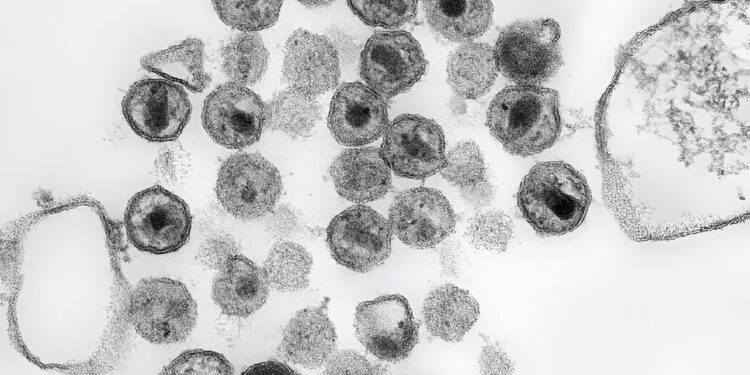Lenacapavir causes the HIV capsid to rupture before it can carry its genetic material to the host cell’s nucleus. Credit: Public Health Image Library, CDC
Just over a year ago, the European Union and the United States Food and Drug Administration approved a new antiretroviral drug to treat human immunodeficiency virus (HIV) infections. Lenacapavir is the first drug available to patients designed to target HIV’s protective armor: the HIV capsid.
An international team of researchers led by UNSW Sydney Medical Researchers now has details of how this new drug pushes the HIV capsid to the breaking point, stopping the virus in its tracks. The molecular mechanisms they discovered are published in the journal eLife and could help refine and design more effective antiviral therapies.
HIV wraps its genetic material in a protein coat to protect the virus as it converts its genomic RNA into DNA en route to the nucleus after entering the target cell. Developed by biopharmaceutical company Gilead Sciences, lenacapavir was designed to counteract this very protection offered by the capsid. This powerful, long-acting drug is the first, and so far only, approved HIV treatment to achieve this goal.
“The fact that the capsid plays a central role at several stages of the viral life cycle and therefore represents a very good drug target is a concept that has only emerged in recent years,” said Professor Till Böcking, who led the team with Dr David Jacques.
It’s hard to build them to break them
By combining cellular infection studies with single-molecule imaging, researchers showed how lenacapavir disrupted the HIV life cycle. Some have speculated that the drug hardens the capsid to enclose the virus, preventing it from developing an infection. Instead, the team found that the capsid, strengthened by the drug, actually became very brittle.
“What we found was that this hyper-stabilization actually led to premature rupture of the capsid, before the virus could finish converting its RNA into DNA,” explained Professor Böcking.
In the target cell, the capsid would rupture before the virus reaches the nucleus, leaving its genetic material exposed to the hostile environment of the host cell’s cytoplasm. To study the effect of lenacapavir on individual capsids over time, the team worked with non-infectious HIV-like particles produced by the cells.
“With our microscope setup, we can examine the integrity of the capsids. By monitoring the release of the fluorescent tags loaded into the capsid, we can determine exactly when it cracks,” said Dr. Walsh, one of the principal authors of the study.
With Dr Leo James and other colleagues at the Molecular Biology Laboratory in the UK, the team also looked at the construction of new capsids, recreating a process that would take place after new copies of the viral genome had been clustered together to be released by infected viruses. cells.
They found that lenacapavir also sabotaged capsid integrity at this phase of the HIV life cycle by speeding up capsid construction to force construction errors. The distorted capsids produced were unable to close properly and would fail to protect the viral genome from attack.
This study not only settles the debate over whether capsid-targeting drugs strengthen or weaken the capsid, but the discovered mechanism could also be exploited to target other viruses that build capsids to protect themselves from capsid defenses. host.
“Lenacapavir is much better than any other capsid-targeting compound. Our results give a very good idea of how incredibly effective this drug can be,” said Dr. Walsh.
More information:
KM Rifat Faysal et al, Pharmacological hyperstabilization of the HIV-1 capsid network induces capsid failure, eLife (2024). DOI: 10.7554/eLife.83605
eLife
Provided by the University of New South Wales
Quote: How a new drug pushes the HIV capsid to the breaking point (February 13, 2024) retrieved February 13, 2024 from
This document is subject to copyright. Apart from fair use for private study or research purposes, no part may be reproduced without written permission. The content is provided for information only.



